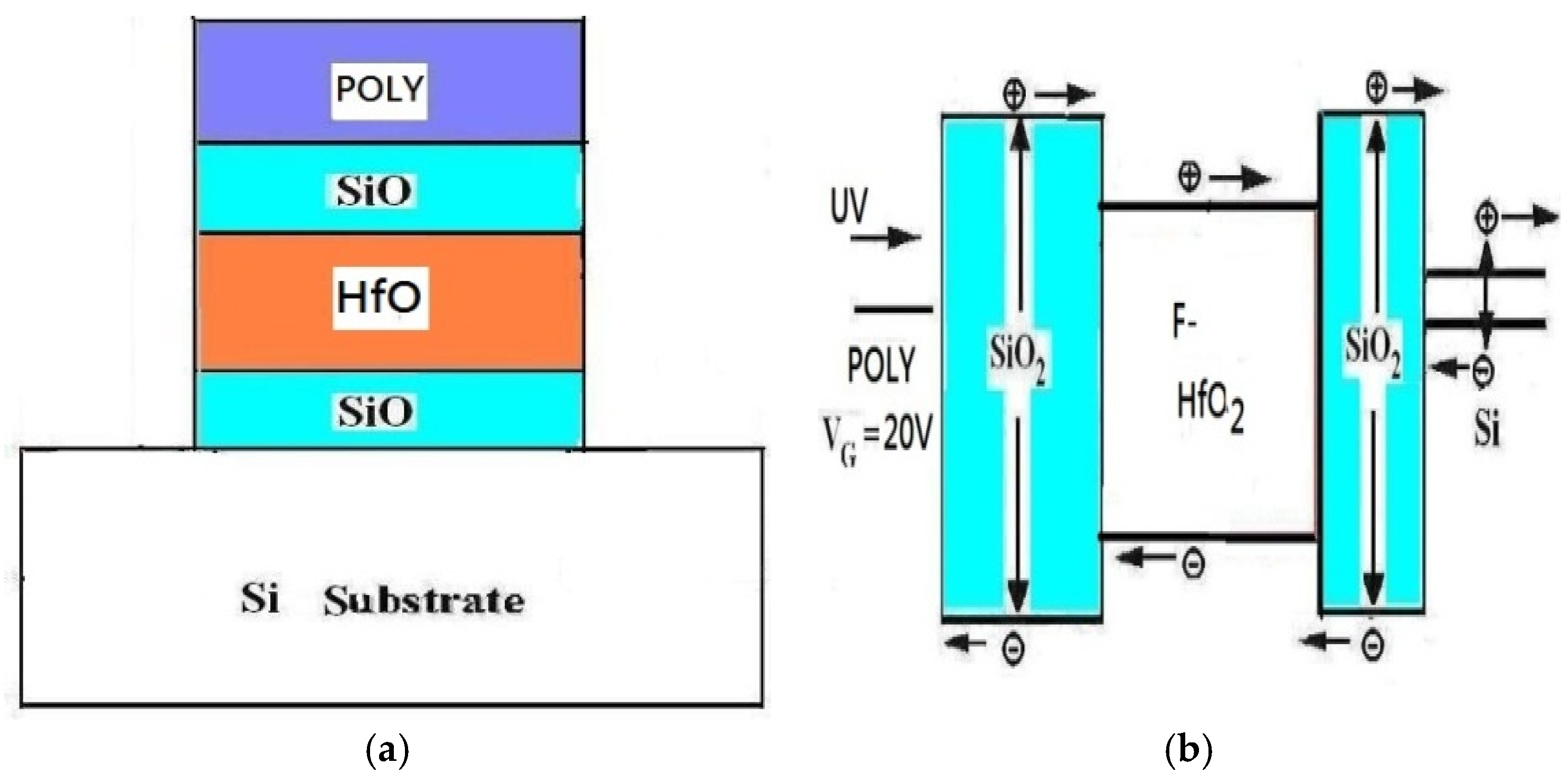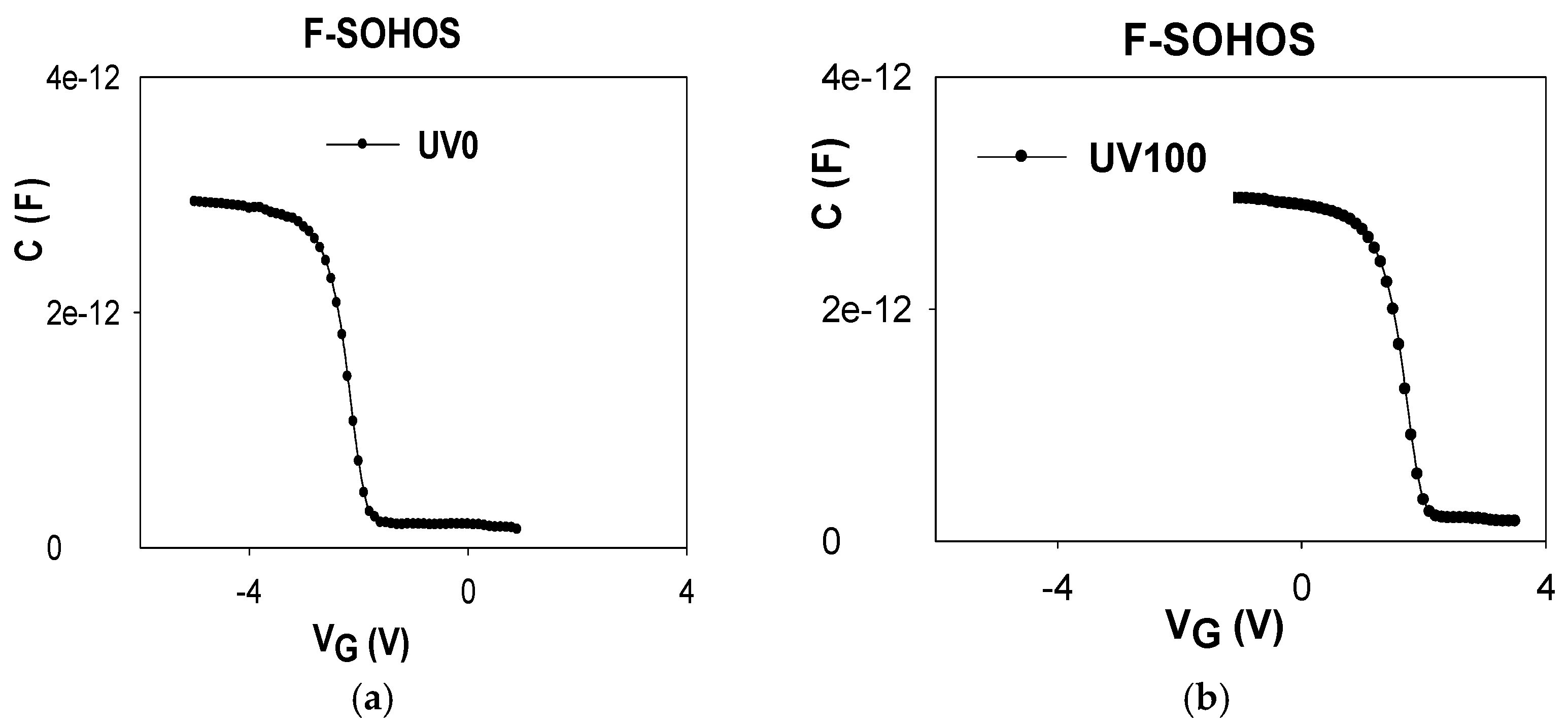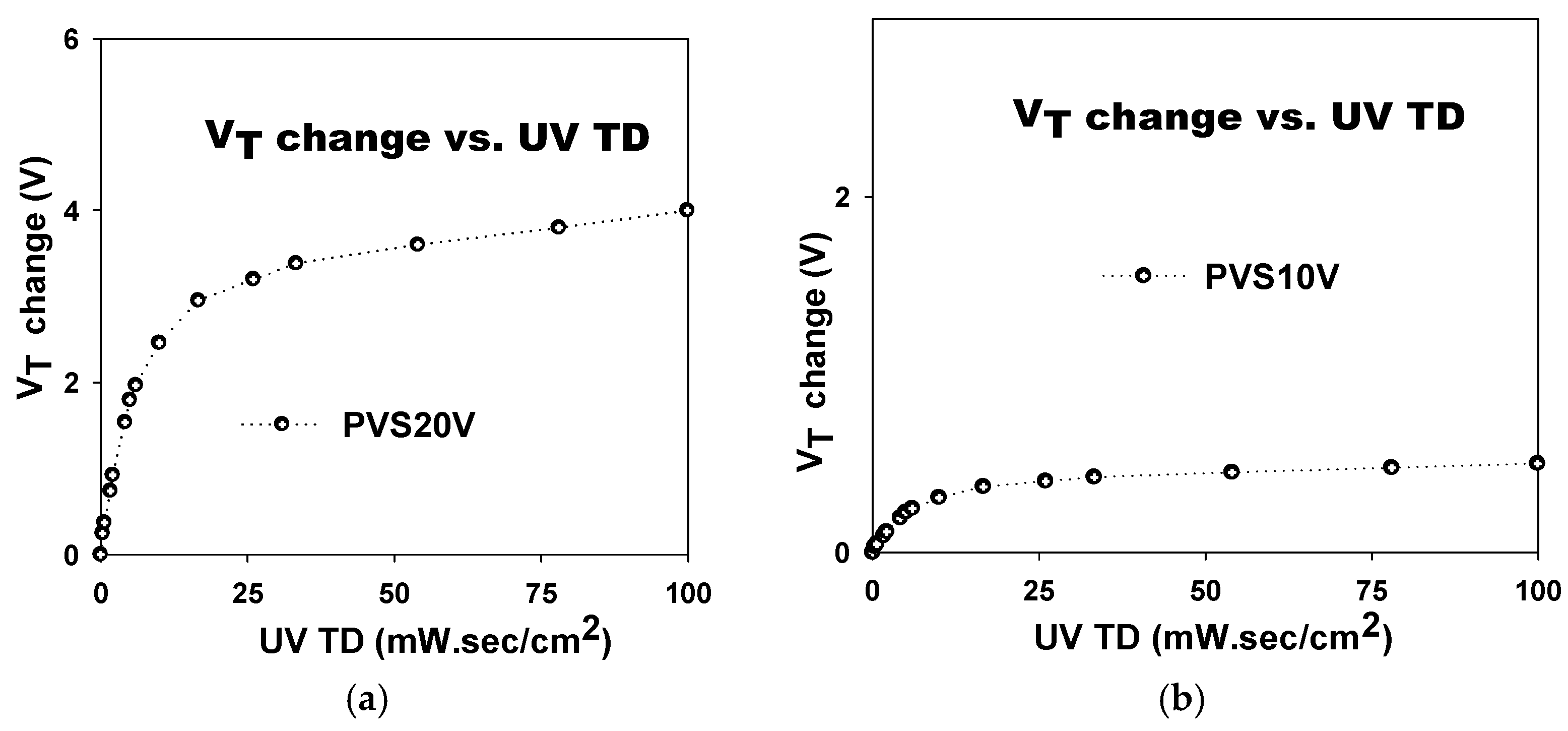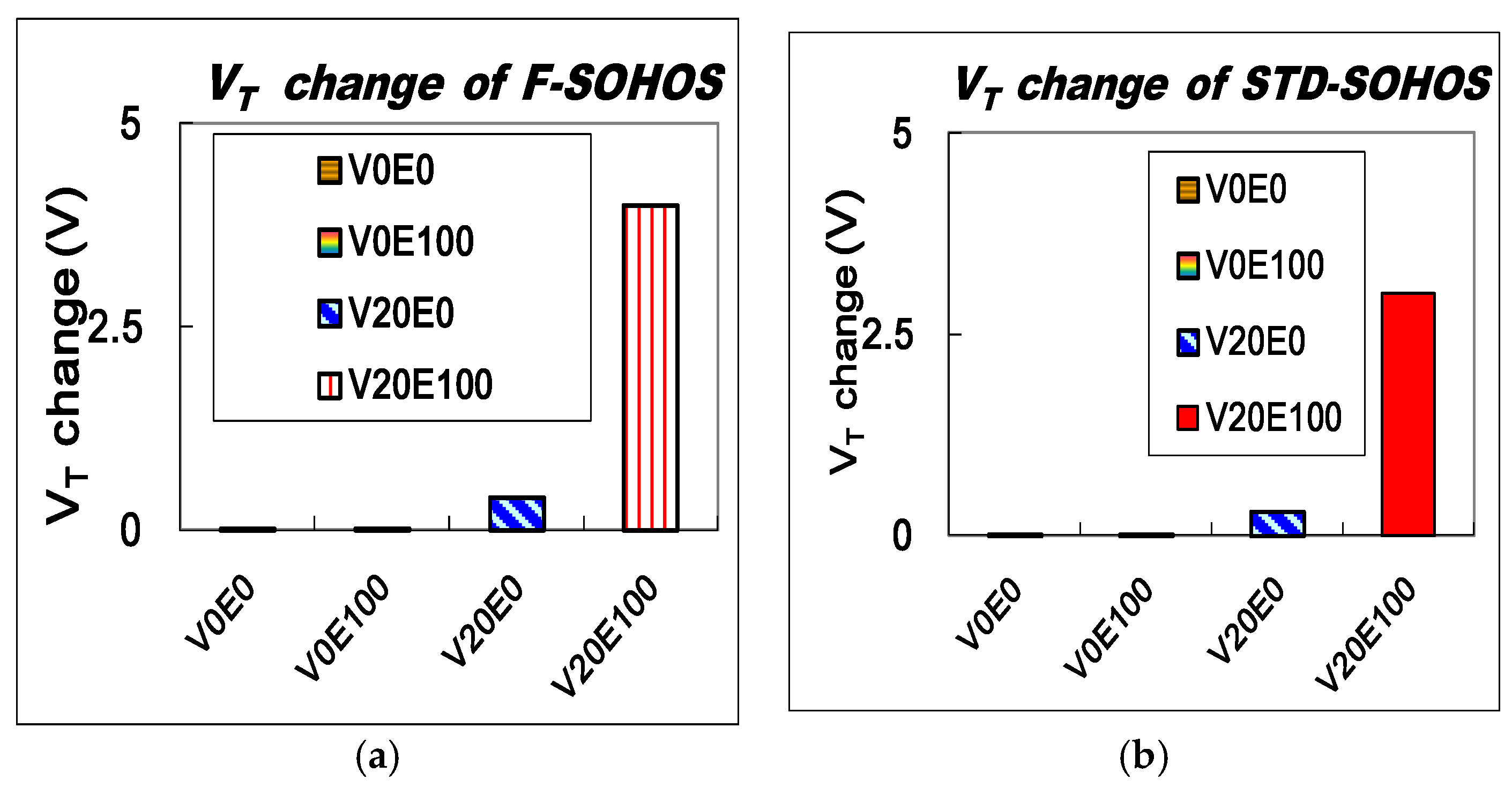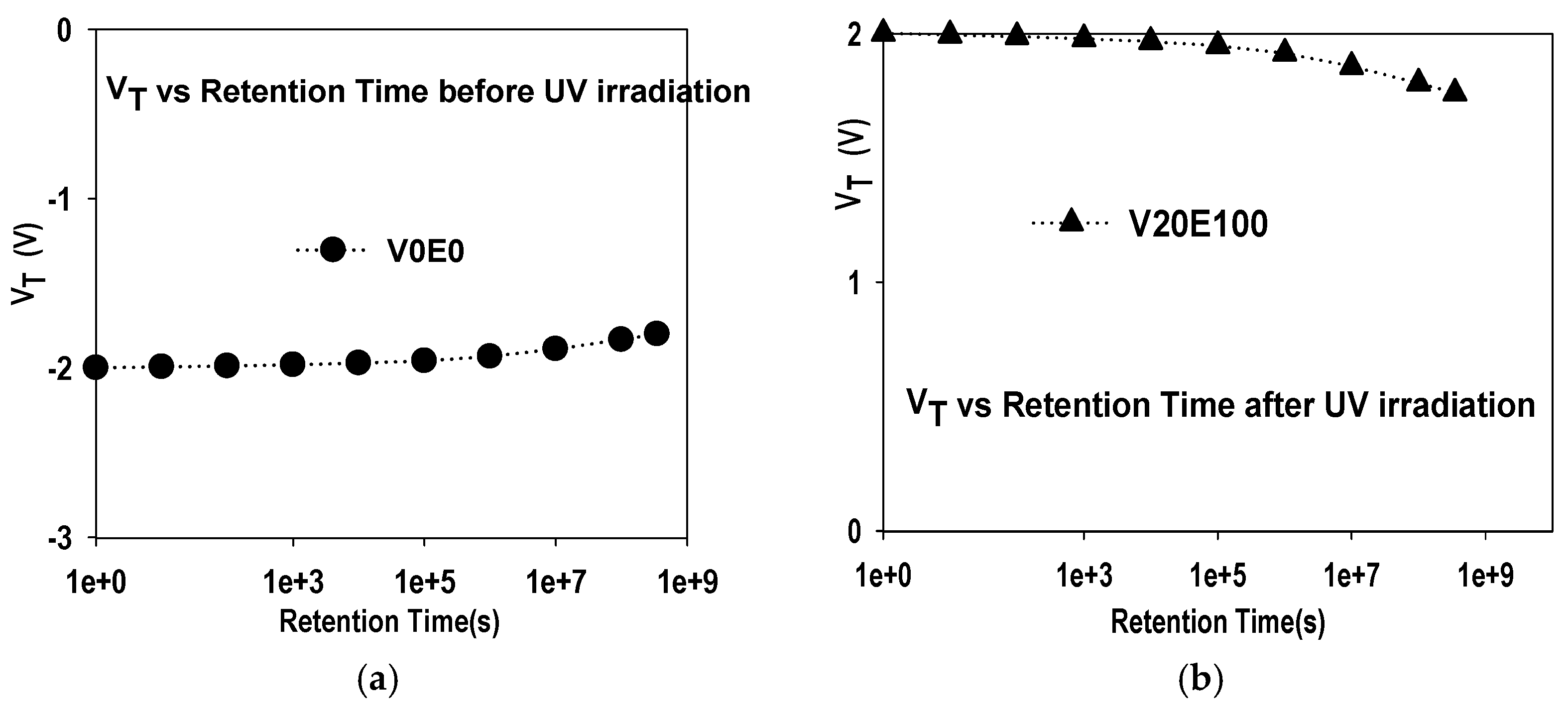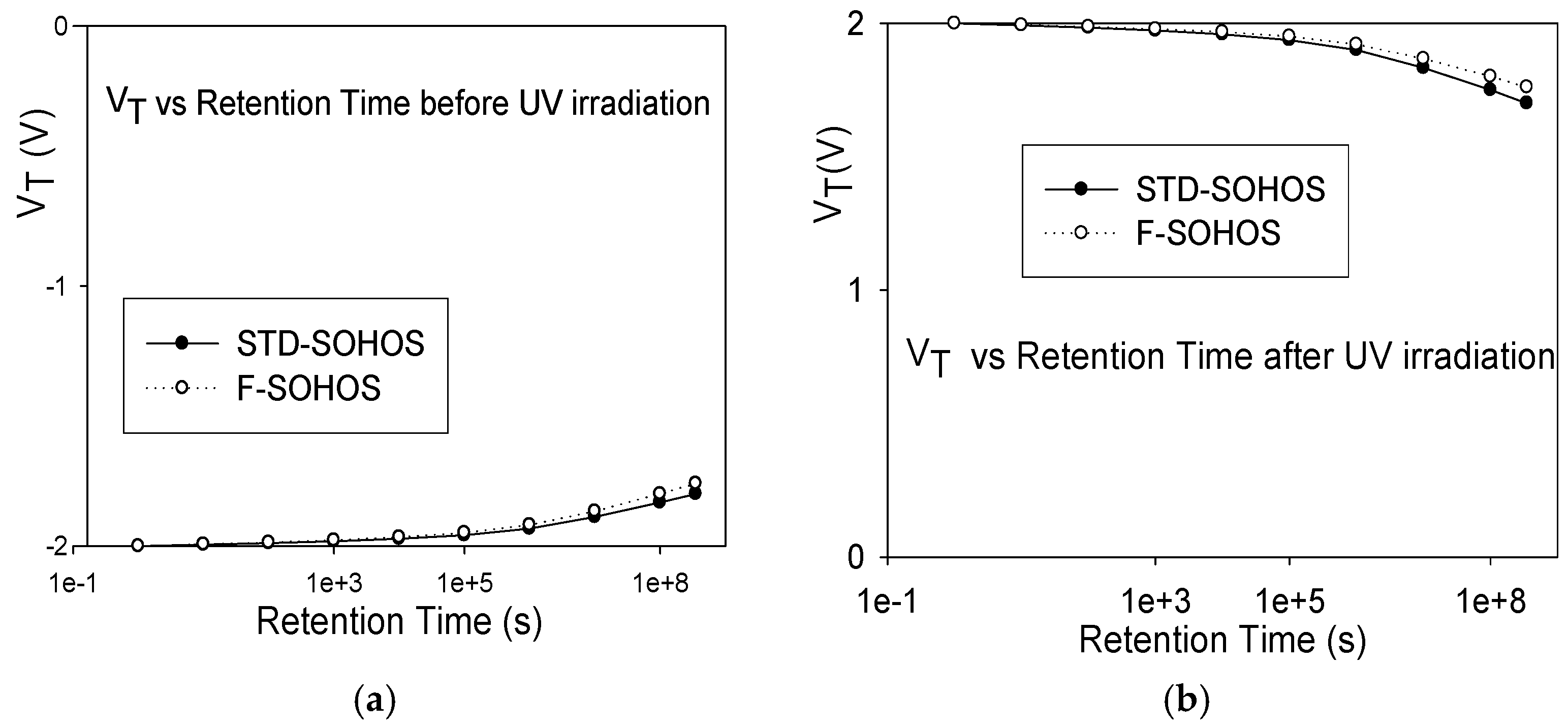3.1. Radiation-Induced VT Shift in F-SOHOS after UV Irradiation
Figure 2a shows a C
G-V
G curve for a F-SOHOS capacitor device before UV irradiation. Before UV TD data writing, gate NVS (V
G = −40 V) was impinged on the F-SOHOS capacitor device to “erase” the native charge in the OHO trapping layer and the F-SOHOS capacitor device is in erased state before UV irradiation. So, the curve shown in
Figure 2a is the curve for a F-SOHOS capacitor device after gate NVS (V
G = −40 V).
Figure 2b shows a C
G-V
G curve for a F-SOHOS capacitor device after 100 mW·s/cm
2 TD UV irradiation under PVS (V
G = 20 V). For UV TD data writing, 100 mW·s/cm
2 TD UV irradiation together with PVS (V
G = 20 V) were impinged simultaneously on the F-SOHOS capacitor devices. As illustrated in
Figure 2b, the C
G-V
G curve of F-SOHOS capacitor shifted to the right after UV total dose (here after TD) up to 100 mW·s/cm
2 irradiation under gate PVS 20 V. This indicates that UV TD 100 mW·s/cm
2 irradiation induces a increase of V
T (about 4 V) for the F-SOHOS capacitor under gate PVS V
G 20 V. This positive V
T shift result is in agreement with previous studies [
1,
2,
3].
The positive V
T shift is due to an increase in net total negative trapped charges accumulated in the OHO gate dielectric layer after UV TD irradiation under gate PVS 20 V. These radiation-induced positive V
T shifts in the UV irradiated F-SOHOS capacitor device under gate PVS 20 V are result from electrons on Si substrate excited by UV photons, and then injected under gate PVS 20V over the Si-SiO
2 potential barrier into the trapping layer, and finally trapped in the nitride trapping layer of OHO [
1,
2,
3]. UV TD irradiation and gate PVS was applied on the F-SOHOS capacitor device simultaneously for writing data by UV radiation. When the F-SOHOS capacitor structures are irradiated by UV TD irradiation, electrons from silicon substrate can be excited by UV photons. These free carriers are swept by electric field under gate PVS over the Si-SiO
2 potential barrier and injected into the OHO gate dielectric layer, and some of these carriers are captured by the charge trap centers in OHO trapping layer. The UV radiation writing induces significant increase of threshold voltage for F-SOHOS capacitor devices. It is considered that this threshold change mostly owing to significant increase of electron trapped charges in the gate dielectric OHO after UV TD data writing. The change of gate threshold voltage in this case can be correlated to the amount of trapped charges and the exposure TD of UV radiation as well. These trapped charges are accumulated in gate dielectric layer, so UV TD record can’t be destroyed or disturbed by UV TD data write and read. For the erase of UV TD data, data in the SOHOS capacitor devices can be erased to original null state by positive charges injection under NVS.
The V
T increase are plotted against the UV irradiation TD for F-SOHOS capacitors under PVS 20 V and PVS 10 V as shown in
Figure 3a,b, respectively. The V
T increase as a function of UV TD for F-SOHOS capacitors device under PVS 20 V are shown in
Figure 3a. The increase in F-SOHOS V
T can be correlated to the increase in UV TD. But the V
T increased more slowly when UV TD larger than 30 mW·s/cm
2. These experimental results in this study are in agreement with previous studies [
1,
2,
3].
The dependence of the V
T shift on UV TID for F-SOHOS capacitor under PVS 20 V was more obvious than that under gate PVS 10 V as shown in
Figure 3a,b. Under higher gate PVS, electrons are swept by higher electric field under higher gate PVS and more electrons were captured by more charge trap centers of OHO trapping layer.
The comparisons of V
T increase of two types of SOHOS capacitor devices after various UV irradiation conditions are shown in
Figure 4a,b. The symbol list for various UV and PVS condition on SOHOS capacitor device are listed in
Table 1. As illustrated in
Figure 4a,b, the change of threshold voltage of SOHOS capacitor was ignorable with only UV TD irradiation conditions (without gate PVS), and also ignorable with only gate PVS conditions (without UV TD irradiation). It is considered that both UV TD irradiation and gate PVS should be applied on the SOHOS capacitor device simultaneously for writing UV TD radiation data, and the significant increase of threshold voltage is due to an significant increase of electron trapped charges in the gate dielectric OHO layer after UV TD irradiation and gate PVS simultaneously. As shown in
Figure 4a,b, it is noted that the UV TD radiation-induced V
T increase of the F-SOHOS capacitor device was nearly 1.5 times larger than that of the STD-SOHOS capacitor device after 100 mW·s/cm
2 UV TD irradiation under 20 V V
G PVS. The UV TD radiation-induced V
T shift of F-SOHOS capacitor is more significant than that of STD-SOHOS capacitor as shown in
Figure 4a,b, which results from the amount of UV TD radiation-induced charge trapped in the F-SOHOS capacitor is greater than that in the STD-SOHOS capacitor under gate PVS. The F-SOHOS capacitor device with larger F-treatment volume in HfO
2 has the higher UV radiation-induced charge density than the STD-SOHOS capacitor devices after UV irradiation. For comparison, two type of the SOHOS capacitor devices had the same thickness of tunneling oxide, trapping nitride, and blocking oxide layer.
3.2. VT Stability vs. Retention Time
The V
T vs. retention time for an F-SOHOS capacitor device before and after UV 100 mW·s/cm
2 irradiation under PVS 20 V are illustrated in
Figure 5a,b, respectively. As illustrated in
Figure 5a, the increase in V
T with time for the pre-UV-irradiated F-SOHOS capacitor device is a result of negative charges naturally tunneling into the HfO
2 trapping layer of F-SOHOS device before UV irradiation. As shown in
Figure 5b, the decrease in the V
T with time for the post-UV-irradiated F-SOHOS capacitor device is a result of UV radiation-induced negative charges tunneling out from the HfO
2 trapping layer. Moreover, the V
T-retention loss of the nonvolatile F-SOHOS capacitor device after 10 years retention is below 15%. For F-SOHOS type nonvolatile device, the electrons in trapping layer are hard to escape to the control gate due to the relatively higher barrier height of thick SiO
2 blocking oxide. As a result, negative charges are accumulated permanently in the layers.
Figure 6a,b show the comparison of the charge retention reliability characteristics of two types of SOHOS capacitor devices before UV irradiation and after UV 100 mW·s/cm
2 irradiation under PVS 20 V. However, an F-SOHOS demonstrated better UV induced charge-retention reliability characteristics than STD-SOHOS. This result also agreed with the previous study of an F-SOHOS device [
5,
10]. A much deeper charge trap energy level (ETA) was observed for an F-SOHOS with fluorine-treated hafnium oxide trapping layer than that for STD-SONOS in the previous study [
5,
10]. Therefore, the F-SOHOS device with deeper charge traps in the fluorine-treated hafnium oxide trapping layer showed better UV induced charge-retention reliability characteristics than the STD-SOHOS devices. The charge-retention loss of the nonvolatile F-SOHOS capacitor after 10 years retention is below 15%. The nonvolatile F-SOHOS capacitor devices have very good reliability characteristics of V
T retention, even for 10 years. The UV TD information can be permanently stored and accumulated in the non-volatile F-SOHOS capacitor devices.
